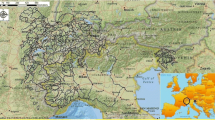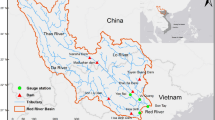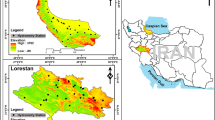Abstract
This study is aimed on successful modeling of Ajichay River Suspended Sediment Load (SSL) which is significant object in watershed planning and management. Therefore, a two-stage modeling strategy was proposed in order to handle spatio-temporal variation of SSL. At temporal stage, Support Vector Machine (SVM) was utilized for three stations located on the Ajichay River to find the non-linear relationship of SSL in time domain. Different input sets were examined for the SVM via sensitivity analysis. Results of temporal modeling stage were used in spatial modeling. In spatial modeling stage, firstly semi-variogram of monthly SSL data was calculated and then theoretical semi-variogram model was fitted to the empirical variogram. It was found that Gaussian model is the best fitted model for the study case. The obtained results of semi-variogram were imported into Geostatistic tool for spatial estimation of SSL in sites where there is not any measurement. Results of temporal modeling stage demonstrated that input data as combination of SSL and discharges at 1 month and 12 monthes ago employing RBF based SVM could lead to the best performance for each station. Spatial modeling performance was improved relatively using streamflow dataset. The obtained results show that the hybrid of SVM and Spatial statistics methods could predict and simulated SSL appropriately by enjoying unique features of both approaches.





Similar content being viewed by others
References
Afan HA, El-Shafie A, Yaseen ZM, Hameed MM, Mohtar WHMW, Hussain A (2015) ANN based sediment prediction model utilizing different input scenarios. Water Resour Manag 29(4):1231–1245
Ch S, Anand N, Panigrahi BK (2013) Streamflow forecasting by SVM with quantum behaved particle swarm optimization. Neurocomputing 101:18–23
Cobaner M, Unal B, Kisi O (2009) Suspended sediment concentration estimation by an adaptive neuro-fuzzy and neural network approaches using hydro-meteorological data. J Hydrol 367(1–2):52–61
Cressie N (1991) Statistics for spatial data. Wiley, New York
de Vente J, Poesen J, Bazzoffi P, Van Rompaey A, Verstraeten G (2006) Predicting catchment sediment yield in Mediterranean environments: the importance of sediment sources and connectivity in Italian drainage basins. Earth Surf Processes Land 31:1017–1034
Dibike YB, Velickov S, Solomatine DP, Abbott MB (2001) Model induction with support vector machines: introduction and applications. J Comput Civ Eng 15:208–216
Goovaerts P (1997) Geostatistics for natural resources evaluation. Oxford University Press, New York
Goovaerts P (2000) Geostatistical approaches for incorporating elevation into the spatial interpolation of rainfall. J Hydrol 228:113–129
Guo J, Zhou J, Qin H (2011) Monthly streamflow forecasting based on improved support vector machine model. Expert Syst Appl 38:13073–13081
Isaaks EH, Srivastava RM (1989) An introduction to applied geostatistics. Oxford University Press, New York
Kakaei E, Moghddamnia A, Ahmadi A (2013) Daily suspended sediment load prediction using artificial neural networks and support vector machines. J Hydrol 478:50–62
Kisi O, Haktanir T, Ardiclioglu M, Ozturk O, Yalcin E, Uludag S (2008) Adaptive neuro-fuzzy computing technique for suspended sediment estimation. Adv Eng Softw 40(6):438–444
Kuhnle RA, and Simon A (2000) Evaluation of Sediment Transport Data for Clean Sediment TMDLs. National Sedimentation Laboratory USDA Agricultural Research Service Oxford, Mississippi. Evaluation of Sediment Transport Data. NSL Report No. 17
Kumar M, Kar IN (2002) Non-linear HVAC computations using least square support vector machines. Energ Convers Manage 50:1411–1418
Liu Y, Yang W, Yu Z, Lung I, Gharabaghi B (2015) Estimating sediment yield from upland and channel erosion at a watershed scale using SWAT. Water Resour Manag 29(5):1399–1412
Ly S, Charles C, Degré A (2011) Geostatistical interpolation of daily rainfall at catchment scale: the use of several variogram models in the ourthe and ambleve catchments. Belgium. Hydrol Earth Syst Sci 15:2259–2274
Matheron G (1963) Principles of geostatistics. Econ Geol Geology 58:1246–1266
Misra D, Oommen T, Agrawal A (2009) Application and analysis of support vector machine based simulation for runoff and sediment yield. Biosyst Eng 103(4):527–535
Moulin L, Gaume E, Obled C (2009) Uncertainties on mean areal precipitation: assessment and impact on streamflow simulations. Hydrol Earth Syst Sci 13:99–114
Noori R, Abdoli MA, Ghasrodashti AA, Jalili Ghazizade M (2009) Prediction of municipal solid waste generation with combination of support vector machine and principal component analysis: a case study of Mashhad. Environ Prog Sustain 28:249–258
Noori R, Karbassi AR, Moghaddamnia A (2011) Assessment of input variables determination on the SVM model performance using PCA, gamma test and forward selection techniques for monthly stream flow prediction. J Hydrol 401:177–189
Nourani V, Andalib G (2015) Daily and monthly suspended sediment load predictions using wavelet based artificial intelligence approaches. J Mt Sci 12(1):85–100
Nourani V, Ejlali RG, Alami MT (2010) Spatiotemporal groundwater level forecasting in coastal aquifers by hybrid artificial neural network-geostatisics model: a case study. Environ Eng Sci 28(3):217–228
Partal T, Cigizoglu HK (2008) Estimation and forecasting of daily suspended sediment data using wavelet-neural networks. J Hydrol 358:317–331
Rouhani S, Hall TJ (1989) Space-time kriging of groundwater data. In: Armstrong M (ed) Geostatistics, Kluwer Academic Publishers, vol 2, pp. 639–651
Roushangar K, Hassanzadeh Y, Keynejad MA, Alami MT, Nourani V, Mouaze D (2011) Studying of flow model and bed load transport in a coarse bed river: case study – Aland river, Iran. J Hydroinform 13(4):850–866
Roushangar K, Mehrabani FV, Shiri J (2014a) Modeling River total bed Material Load Discharge Using Artificial Intelligence Approaches (Based on Conceptual Inputs). J Hydrol 514:114–122
Roushangar K, Mouaze D, Shiri J (2014b) Evaluation of genetic programming -based models for simulating friction factor in alluvial channels. J Hydrol 517:1154–1161
Sun D, Li Y, Wang Q (2012) A novel support vector regression model to estimate the phycocyanin concentration in turbid inland waters from hyperspectral reflectance. Hydrobiologia 680:199–217. doi:10.1007/s10750-011-0918-7
Syed KH, Goodrich DC, Myers DE, Sorooshian S (2003) Spatial characteristics of thunderstorm rainfall fields and their relation to runoff. J Hydrol 271:1–21
Tayfur G, Ozdemir S, Singh VP (2003) Fuzzy logic algorithm for runoff-induced sediment transport from bare soil surfaces. Adv Water Resour 26(12):1249–1256
USEPA (2000) The Quality of Our Nation’s Waters. A Summary of the National Water Quality Inventory: 1998 Report to Congress, Office of Water. 841-S-00-001 Washington DC
Vapnik V (1998) Statistical learning theory. Wiley, New York
Vapnik V, Cortes C (1995) Support vector networks. Mach Learn 20(3):273–297
Wang W, Xu D, Chau K, Chen S (2013) Improved annual rainfall-runoff forecasting using PSO-SVM model based on EEMD. J Hydroinform 15:1377–1390
Webster R, Oliver MA (2007) Geostatistics for environmental scientists, Statistics in Practice Series. Wiley, United Kingdom
Wilkinsona SN, Dougallb C, Kinsey-Hendersonc AE, Searled RD, Ellisb RJ, Bartleyd R (2014) Development of a time-stepping sediment budget model for assessing land use impacts in large river basins. Sci Total Environ 468-469:1210–1224
Zhu YM, Lu XX, Zhou Y (2007) Suspended sediment flux modeling with artificial neural network: an example of the longchuanjiang river in the upper Yangtze catchment, China. Geomorphology 84:111–125
Acknowledgments
This paper is supported by the University of Tabriz and East Azerbaijan regional water company.
Author information
Authors and Affiliations
Corresponding author
Rights and permissions
About this article
Cite this article
Nourani, V., Alizadeh, F. & Roushangar, K. Evaluation of a Two-Stage SVM and Spatial Statistics Methods for Modeling Monthly River Suspended Sediment Load. Water Resour Manage 30, 393–407 (2016). https://doi.org/10.1007/s11269-015-1168-7
Received:
Accepted:
Published:
Issue Date:
DOI: https://doi.org/10.1007/s11269-015-1168-7




